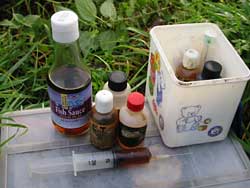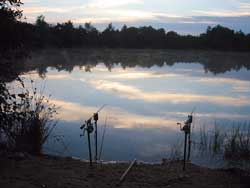Why flavour a bait? To help Mr or hopefully Mrs Pike find and eat your bait above all the other food in the water. What do I use to flavour a bait? Off-the-shelf bottles of herring oil, smelt oil etc… from the local tackle shop and also supermarket flavours. Where and when do I use them? Wherever and whenever you go pike fishing. All of the above questions have pretty obvious answers, I know. And they can be broken down into many, many more questions, the answers to which I may not be able to give you. But I can hopefully point you in the right direction and give you a few little tips along the way. I treat rivers and stillwaters differently when it comes to bait flavouring. On a river it is possible to draw fish up stream to your bait using the flow to carry your flavour. On a Stillwater this is not possible, unless it is a large one with a good undertow. Stillwater pike tend to have patrol routes that take them around the pit and past any likely looking feeding areas. A bait placed near one of these is always a good bet for a fish. Stillwaters As you can imagine, a stronger, more concentrated flavour is needed on a stillwater as it wont spread very far and the chances of a pike picking up on it must be maximised. But a flowing river needs a larger quantity of flavour, but not too strong. Try drinking neat vodka. You can’t have a lot of it before it gets too much to handle. Now add some orange juice to thin it out a bit… get the idea! hic… Stillwaters are where I use the off-the-shelf bottles of oils and flavours. I have found that unless the pike are feeding on one bait to the exclusion of all others then it doesn’t make a lot of difference what flavour oils you use with what bait. Smelt flavoured with sardine oil seems to be a good combo as does roach or skimmers with herring oil. By mixing baits and flavours I think you tend to fool the wary pike on pressured waters. A good example of this was an outing to a Norfolk gravel pit. Three of us made the trip that day. Rich was fishing the margins of a lovely looking bay. Chris had a bait in the mouth of the bay and one under a drifter float. I was long range legering using a baitboat. With the use of a sounder I had placed one plain bait just short of a gravel bar and the other, a roach flavoured with sardine oil on the other side of the gravel bar drop-off. The only fish of the day was a spirited low double to the flavoured bait. Scents can also be used with livebaits. Get a length of rig tube and attach a piece of sponge to one end and a lead weight to the other. You can then use the sponge to carry the flavours, as I am sure that pumping 5ml of sardine oil into a roach would soon see a transformation from a livebait to a dead one. It’s also a good rig to use in clear water when the pike are lethargic and can see the bait, but need a little something to wet the appetite. In weedy waters flavouring can also help no end. Use a legered bait with a stem a couple of inches longer than the weed. Cast out but don’t tighten up too much, just enough for efficient bite indication. Too much tightening will take the bait into the weed and impair the hooks. But a flavoured bait sat just above a weedbed can make a tempting meal. Rivers Before a trip down the river I reach for a bottle of Nam Pla. Have a look for it in Tescos next time you go shopping. It’s a Thai cooking oil/fish sauce. The fact that its dirt cheap and runny make it top of my list for running water flavours. You can inject 20ml or more into a bait until its running out of its eyes, mouth and vent then cast it out knowing that it will provide a scent trail for hours. A trip to a local stretch of river last October springs to mind. I arrived at midday. The Rainbow trout deadbait with Nam Pla was cast out to a good area where pike following the scent up the river couldn’t miss it. The other rod was set up with a free roving livebait rig and four pike to around 7lbs fell to the 5 inch trotted roach baits. A half-hearted run on the trout was missed at about 2pm, but the bait came back with some good teeth marks on it. The bait was changed and recast to the same spot and the livebaits were swapped for deads. A trotted dead roach gave me a 12lb fish at 3pm and just as I was about to start packing up at 4pm the trout rod went again. A solid whack saw me into an 18lb 8 oz fish that had followed the scent trail to my bait. As described above pop-ups are an extremely effective method to use when coupled with flavours. But don’t limit their use to just stillwaters. A popped-up bait, either straight off the lead or on a Poppernoster type rig (see link below) will wave about in the flow. Now I have no illusions about whether or not the pike can tell if the bait is dead or not, but a roach waving about in the current is such a visible bait and as such its worth getting the rig right and filling the bait with flavour.
Injecting Baits There is one important issue that I have missed out so far. How do you actually inject the bait with flavour? This again seems like an easy to answer question, but I have found that by injecting in different ways you can get different results. When I inject large amounts of Nam Pla into a big bait, such as a trout deadbait or large skimmer, I usually poke the needle up the fishes vent. Sounds gross, but here is my thinking: The stomach and intestine of the fish gets filled up with the flavour. The outside of the fish stretches and puts pressure on the stomach. The only way out for the flavour is through the throat and the vent. This creates a slow trickle of flavour rather than a big explosion that gets washed away. When a pike picks up the bait any remaining flavour is normally squeezed out and you can sometimes detect a take by seeing the ripples calm down as the oils escape, then the float go. Injecting smaller quantities of flavour is done through the bait’s flank. The hole that the syringe makes will be enough to allow the oils and other tasty bits to leak out of the fish. If you use this method with large quantities of oil then you will find that it all comes out over the bank and you are left with very little in your bait when it hits the bottom of the lake. Lastly, whenever you are injecting baits with anything, watch your fingers. Believe me when I say that needles going through a roach and sticking into your hand hurt! They also leave you open to all sorts of infection. So be warned and be careful. You should also keep the little cover on the needle when it’s not in use. Another tip is to wash your syringe with warm soapy water after each trip. It stops the oils from deteriorating the rubber seals and keeps the needles clean. The Nam Pla has a high salt content so it tends to crystallise and can cause blockages that you normally don’t find out about until the needle comes off the end and the flavour goes everywhere. Anyway, happy flavouring and tight lines… |
Welcome!Log into your account













